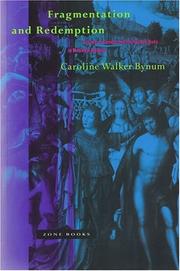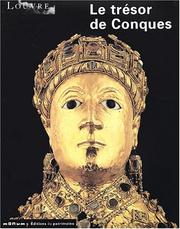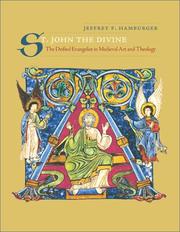| Listing 1 - 10 of 18 | << page >> |
Sort by
|
Periodical
Publisher: Paris Musée de Cluny - le monde médiéval
Abstract | Keywords | Export | Availability | Bookmark
 Loading...
Loading...Choose an application
- Reference Manager
- EndNote
- RefWorks (Direct export to RefWorks)
Museology --- Art --- Cluny museum: national museum of middle ages [Paris]
Book
ISBN: 9781409451501 9781409451518 9781472406705 140945150X 9781315562988 9781134797745 Year: 2015 Publisher: Burlington : Ashgate,
Abstract | Keywords | Export | Availability | Bookmark
 Loading...
Loading...Choose an application
- Reference Manager
- EndNote
- RefWorks (Direct export to RefWorks)
This book provides an introduction to current work and new directions in the study of medieval liturgy. It focuses primarily on so-called occasional rituals such as burial, church consecration, exorcism and excommunication rather than on the Mass and Office. Recent research on such rites challenges many established ideas, especially about the extent to which they differed from place to place and over time, and how the surviving evidence should be interpreted. These essays are designed to offer guidance about current thinking, especially for those who are new to the subject, want to know more about it, or wish to conduct research on liturgical topics. Bringing together scholars working in different disciplines (history, literature, architectural history, musicology and theology), time periods (from the ninth to the fifteenth centuries) and intellectual traditions, this collection demonstrates the great potential that liturgical evidence offers for understanding many aspects of the Middle Ages. It includes essays that discuss the practicalities of researching liturgical rituals; show through case studies the problems caused by over-reliance on modern editions; explore the range of sources for particular ceremonies and the sort of questions which can be asked of them; and go beyond the rites themselves to investigate how liturgy was practised and understood in the medieval period.
Liturgics. --- Church history --- 264 "04/14" --- Liturgiology --- Public worship --- Liturgies --- Liturgie--Middeleeuwen --- 264 "04/14" Liturgie--Middeleeuwen --- 264 <09> --- Christianity --- Liturgy --- 264 <09> Liturgie--Geschiedenis van ... --- Liturgie--Geschiedenis van ... --- Middle Ages, 600-1500 --- Christian church history --- anno 500-1499 --- Liturgics --- Church history - Middle Ages, 600-1500. --- Liturgie latine

ISBN: 0942299620 0942299639 9780942299625 Year: 1992 Publisher: New York (N.Y.): Zone books,
Abstract | Keywords | Export | Availability | Bookmark
 Loading...
Loading...Choose an application
- Reference Manager
- EndNote
- RefWorks (Direct export to RefWorks)
Les sept essais de la célèbre historienne Caroline Walker Bynum illustrent son argument selon lequel les historiens doivent écrire de manière "comique", conscients des artifices, des risques et des lacunes de l’histoire. Explorant un large éventail de textes médiévaux, les essais montrent comment les femmes ont réussi à s'approprier les symboles sociaux dominants d'une manière qui les révise et les atténue, permettant ainsi à leurs propres voix créatives et religieuses d'émerger. Pris ensemble, ils fournissent un modèle de prise en compte du genre dans l’étude des textes médiévaux et offrent une nouvelle interprétation du rôle de l’ascèse et du mysticisme dans le christianisme. Dans les trois premiers essais, Bynum se concentre sur les problèmes méthodologiques inhérents à l'écriture de l'histoire. Elle montre que la prise en compte des textes médiévaux écrits par les femmes et des rituels qui les attirent sape les approches de trois figures intellectuelles du XXe siècle - Victor Turner, Max Weber et Leo Steinberg - et montre comment d'autres disciplines peuvent enrichir la recherche historique. Ces considérations méthodologiques sont ensuite utilisées dans les trois prochains essais pour examiner le genre proprement dit. Tout en décrivant les voix littéraires "expérimentales" des femmes médiévales, Bynum souligne la corporalité de la piété féminine et se concentre à la fois sur la construction culturelle et la physionomie insondable du corps lui-même. Elle examine également comment les actes et les attitudes des hommes ont affecté la construction culturelle de catégories telles que "femme", "hérétique" et "sainte" et montre que l'étude du genre est l'étude de la manière dont les rôles et les possibilités sont conceptualisés par les deux femmes. et les hommes. Dans le dernier essai, Bynum explique comment les discussions médiévales sur la résurrection physique et l'obsession des détails matériels enrichissent les débats modernes sur les questions d'identité et de survie.
Christian spirituality --- anno 500-1499 --- -De mens. Theologische antropologie --- Human body --- Sex role --- Women in Christianity --- Women --- Religious aspects --- Christianity --- History of doctrines --- History. --- Gender role --- Sex (Psychology) --- Sex differences (Psychology) --- Social role --- Gender expression --- Sexism --- Body, Human --- Human beings --- Body image --- Human anatomy --- Human physiology --- Mind and body --- Human females --- Wimmin --- Woman --- Womon --- Womyn --- Females --- Femininity --- History --- Middle Ages, 600-1500 --- Addresses, essays, lectures --- Body, Human - Religious aspects - Christianity - History of doctrines - Middle Ages, 600-1500. --- Sex role - Religious aspects - Christianity - History of doctrines - Middle Ages, 600-1500. --- Women (Christian theology) - History of doctrines - Middle Ages, 600-1500. --- Women in Christianity - History. --- 233 --- De mens. Theologische antropologie --- Moyen-âge --- Femme --- Féminisme --- Corps humain, thème --- Religion catholique --- Sexualité --- Middle Ages, 500-1500 --- Moyen Âge --- Body, Human - Religious aspects - Christianity - History of doctrines - Middle Ages, 600-1500 --- Sex role - Religious aspects - Christianity - History of doctrines - Middle Ages, 600-1500 --- Women - Religious aspects - Christianity - History of doctrines - Middle Ages, 600-1500 --- Women in Christianity - History --- Mystique féminine --- Gender roles --- Gendered role --- Gendered roles --- Role, Gender --- Role, Gendered --- Role, Sex --- Roles, Gender --- Roles, Gendered --- Roles, Sex --- Sex roles --- GENDER --- WOMEN --- WOMEN IN CHRISTIANITY --- CORPS HUMAIN --- ROLE SELON LE SEXE --- HISTORY OF DOCTRINES --- ASPECT RELIGIEUX
Book
ISBN: 3879403740 3879403864 Year: 1991 Publisher: Konstanz Universitätsverlag Konstanz
Abstract | Keywords | Export | Availability | Bookmark
 Loading...
Loading...Choose an application
- Reference Manager
- EndNote
- RefWorks (Direct export to RefWorks)
Carnival --- Middle Ages --- Dark Ages --- History, Medieval --- Medieval history --- Medieval period --- World history, Medieval --- World history --- Civilization, Medieval --- Medievalism --- Renaissance --- Fasnacht --- Fastnacht --- Mardi Gras (Festival) --- Pre-Lenten festivities --- Festivals --- Masks --- Shrove Tuesday --- History --- Europe --- Social life and customs. --- Folklore --- Iconography --- History of civilization --- Carnival [pre-Lenten festival]
Periodical
ISSN: 09220887 Publisher: Hilversum : Verloren,
Abstract | Keywords | Export | Availability | Bookmark
 Loading...
Loading...Choose an application
- Reference Manager
- EndNote
- RefWorks (Direct export to RefWorks)
History of civilization --- anno 1400-1499 --- Beschaving [Middeleeuwse ] --- Civilisation médiévale --- Civilization [Medieval ] --- Civilization [Medieval ]--History --- Europa--Beschaving--476-1492 --- Europe--Civilisation--476-1492 --- Europe--Civilization--476-1492 --- Medieval civilization --- Middeleeuwen --- Middeleeuwen--Beschaving --- Middeleeuwen--Cultuur --- Middeleeuwse beschaving --- Middeleeuwse cultuur --- Middle Ages --- Middle Ages--Civilization --- Moyen Âge --- Moyen-Age--Civilisation --- Moyen-Âge --- Périodiques --- Tijdschriften --- Moyen Age --- Periodicals --- 940.1 <05> --- 940.1 --- Geschiedenis van Europa: Middeleeuwen:--(ca.375-1492)--Tijdschriften --- History Europe Middle Ages (476 - 1453) --- 940.1 <05> Geschiedenis van Europa: Middeleeuwen:--(ca.375-1492)--Tijdschriften --- Périodiques
Periodical
ISSN: 0016920X Year: 1964 Publisher: New York (N.Y.): International center of medieval art,
Abstract | Keywords | Export | Availability | Bookmark
 Loading...
Loading...Choose an application
- Reference Manager
- EndNote
- RefWorks (Direct export to RefWorks)
Art --- Art, Romanesque --- Architecture, Romanesque --- Middle Ages --- Civilization, Medieval --- Art roman --- Architecture romane --- Moyen Age --- Civilisation médiévale --- Periodicals. --- Periodicals --- Périodiques --- Art, Medieval --- Architecture, Medieval --- Architecture romane. --- Art médiéval. --- Art roman. --- JEX16 --- Arts and Humanities --- Architecture, Fine and Decorative Arts --- History --- Performing Arts, Travel and Leisure --- anno 500-1499 --- Art, Romanesque - Periodicals --- Architecture, Romanesque - Periodicals --- Art, Medieval - Periodicals --- Architecture, Medieval - Periodicals --- Art roman - Périodiques --- Architecture romane - Périodiques

ISBN: 2858226636 2901785182 9782858226634 9782901785187 Year: 2001 Publisher: Paris: Éd. du patrimoine,
Abstract | Keywords | Export | Availability | Bookmark
 Loading...
Loading...Choose an application
- Reference Manager
- EndNote
- RefWorks (Direct export to RefWorks)
plate [metal, visual works] --- Applied arts. Arts and crafts --- Conques --- Goldwork, Medieval --- Orfèvrerie médiévale --- Exhibitions --- Church plate --- Reliquaries --- Relics and reliquaries --- Containers --- Religious articles --- Shrines --- Communion plate --- Liturgical objects --- Plate --- Sainte-Foy de Conques (Abbey) --- Conques (Aveyron, France). --- Religious silver art --- Middle Ages --- plate [silver or gold tableware] --- Orfèvrerie médiévale --- Church plate - France - Conques (Aveyron) - Exhibitions. --- Reliquaries - France - Conques (Aveyron) - Exhibitions. --- Fides v. m. Aginni --- Iconographie --- Trésor

Abstract | Keywords | Export | Availability | Bookmark
 Loading...
Loading...Choose an application
- Reference Manager
- EndNote
- RefWorks (Direct export to RefWorks)
Throughout the Middle Ages, John the Evangelist, identified as the author of both the Book of Revelation and the most profound and theologically informed of the four Gospels, provided monks and nuns with a figure of inspiration and an exemplar of vision and virginity. Rather than the historical apostle, this book's protagonist is a persona of the Evangelist established in theology, the liturgy, and devotional practice: the model mystic, who, by virtue of his penetrating insight, was seen as having become a mirror image of Christ. In 'St. John the Divine, 'Jeffrey Hamburger identifies a remarkable set of images from the ninth to the fifteenth centuries that identify the inspired Evangelist so closely with the deity that he appears as his living image and embodiment. Hamburger explores the ways these representations of St. John in the guise of Christ elucidate the significance of images as such in medieval theology and mysticism. Above all, he shows how these artworks, presented together for the first time, epitomize the relationship between the visible and the invisible: between ideas, however abstract, and the concrete images that medieval Christians confronted face-to-face.
Christian theology --- Iconography --- John [Evangelist] --- anno 500-1499 --- Europe --- Christian art and symbolism --- Art et symbolisme chrétiens --- John, --- 226.5 --- -Art, Christian --- Art, Ecclesiastical --- Arts in the church --- Christian symbolism --- Ecclesiastical art --- Religious art, Christian --- Sacred art --- Symbolism and Christian art --- Art --- Symbolism --- Christian antiquities --- Church decoration and ornament --- Evangelie volgens Johannes --- John the Apostle, Saint --- -Evangelie volgens Johannes --- Art et symbolisme chrétiens --- Giovanni, --- Hovhannēs, --- Ioann, --- Jan, --- Jean, --- Jehan, --- Johannes, --- Yūḥannā, --- Beloved Disciple --- John --- Medieval, 500-1500 --- Middle Ages, 500-1500
Book

ISBN: 9789462083783 Year: 2017 Publisher: Amsterdam : Rijksmuseum,
Abstract | Keywords | Export | Availability | Bookmark
 Loading...
Loading...Choose an application
- Reference Manager
- EndNote
- RefWorks (Direct export to RefWorks)
Malouel, Jean --- hofkunst --- geschiedenis --- techniek --- heraldiek --- boekverluchting --- middeleeuwen --- Maelwael, Johan --- Maelwael, Herman --- Maelwael, Willem --- Gebroeders van Limburg --- Filips de Stoute (Hertog van Bourgondië) --- Jan zonder Vrees (Hertog van Bourgondië) --- 14de eeuw --- 15de eeuw --- Nijmegen --- Bourgondië --- Parijs --- Dijon --- Frankrijk --- Nederlanden --- Exhibitions --- Art [Medieval ] --- Christian art and symbolism --- Medieval, 500-1500 --- Art [Netherlandish ] --- 14th century --- 15th century --- Painting [Medieval ] --- Middle Ages, 500-1500 --- wapenschilden, heraldiek --- middeleeuwen, middeleeuwse geschiedenis (historisch tijdvak) --- hofkunst. --- geschiedenis. --- techniek. --- wapenschilden, heraldiek. --- boekverluchting. --- middeleeuwen, middeleeuwse geschiedenis (historisch tijdvak). --- Maelwael, Johan. --- Maelwael, Herman. --- Maelwael, Willem. --- Gebroeders van Limburg. --- Filips de Stoute (Hertog van Bourgondië). --- Jan zonder Vrees (Hertog van Bourgondië). --- 14de eeuw. --- 15de eeuw. --- Nijmegen. --- Bourgondië. --- Parijs. --- Dijon. --- Frankrijk. --- Nederlanden.

ISBN: 9042915404 9789042915404 Year: 2004 Publisher: Louvain: Peeters,
Abstract | Keywords | Export | Availability | Bookmark
 Loading...
Loading...Choose an application
- Reference Manager
- EndNote
- RefWorks (Direct export to RefWorks)
churches [buildings] --- Religious architecture --- anno 500-1499 --- Architecture [Medieval ] --- Architecture médiévale --- Architectuur [Middeleeuwse ] --- Bouwkunst [Middeleeuwse ] --- Medieval architecture --- Middeleeuwse architectuur --- Middeleeuwse bouwkunst --- Church decoration and ornament --- Christian art and symbolism --- Architecture, Medieval. --- Rural churches --- Eglises --- Art et symbolisme chrétiens --- Eglises rurales --- History. --- Décoration et ornement --- Histoire --- Architecture, Medieval --- History --- 726.54 --- 72.033 --- 247 "04/14" --- Kerken. Parochiekerken --- Bouwstijlen van de Middeleeuwen (ca 476-1492) --- Kerkdecoratie. Kerkmeubilair--Middeleeuwen --- 72.033 Bouwstijlen van de Middeleeuwen (ca 476-1492) --- 726.54 Kerken. Parochiekerken --- Art et symbolisme chrétiens --- Architecture médiévale --- Décoration et ornement --- Church work, Rural --- Churches, Country --- Churches, Rural --- Country churches --- Village churches --- Church work --- Rural clergy --- Suburban churches --- Church ornament --- Ecclesiastical decoration and ornament --- Decoration and ornament --- Interior decoration --- Religious articles --- Art, Christian --- Art, Ecclesiastical --- Arts in the church --- Christian symbolism --- Ecclesiastical art --- Symbolism and Christian art --- Religious art --- Symbolism --- Middle Ages --- Europe --- Medieval, 500-1500 --- Middle Ages, 500-1500 --- Symbolism in art --- Church decoration and ornament - Europe - History --- Christian art and symbolism - Europe - Medieval, 500-1500 --- Rural churches - Europe - History --- church interiors
| Listing 1 - 10 of 18 | << page >> |
Sort by
|

 Search
Search Feedback
Feedback About UniCat
About UniCat  Help
Help News
News